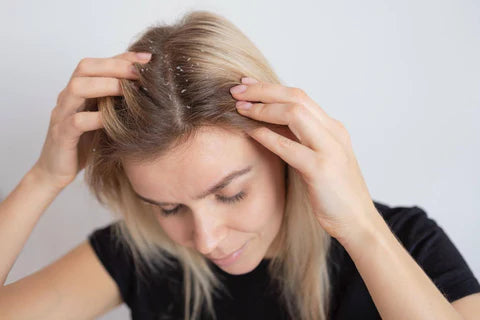Everything you need to know about this surprisingly common skin condition

Seborrheic dermatitis (SD), most famous for the dandruff it can cause, is a much more common condition than you might think. Do you know what causes dandruff and some of the lesser-known symptoms? Read on! Image by Freepik.
One in ten.
That’s how common seborrheic dermatitis (SD) is. Most famous (or infamous) for its role in triggering dandruff, it’s a much more complicated condition than you might think, and one I’m asked about all too frequently. Sometimes mild and discreet, other times very visible, SD can have a devastating effect on self-esteem.
What is Seborrheic Dermatitis?
Contrary to popular belief, SD isn’t a hair condition but a skin condition, though chances are you’re familiar with the hallmark symptom, dandruff. Oily flakes and inflamed patches of skin are other classic manifestations of SD that you may not be as familiar with but people who experience this condition absolutely will recognize.
SD is a form of eczema. It’s a chronic, inflammatory skin reaction triggered by increased oil production and the subsequent overgrowth of a usually harmless yeast called Malassezia furfur. Because the yeast seems to thrive on oil, the focus of symptoms (scaly, inflamed non-itchy patches of skin that can come and go) tends to be where oil glands are present – around the nose, mouth, eyebrows, ears, scalp, chest – anywhere your skin tends to produce oil. That’s a bit counterintuitive since we often associate flakey skin with dryness. On fair skin SD presents as red, inflamed patches of skin, but on pigmented skin it can present as lighter patches that resolve as the condition is brought under control.
Although everyone has this yeast growing on their skin, not everyone who experiences oily skin episodes will react to the overgrowth and develop SD. That’s because you need to be susceptible to the condition (there’s likely a genetic component), which also means you can’t catch it, though it can spread if left untreated. It’s chronic, so though symptoms typically vary and change with time, the seasons, aggravating factors (like stress and hormones), and weather, it doesn’t ever really go away. And though there are treatment options for SD, there’s no cure.
What are the Treatment Options?
SD is a predisposition that you can’t get rid of, and the yeast also can’t be eradicated, so treatment is management. Identifying and avoiding triggers is important, and everyone is unique – for example, some people find the summer months useful for managing SD, others find it aggravating.

One of the best things you can do to keep seborrheic dermatitis at bay? Regular shampooing helps keep the oil and yeast that can trigger the condition at bay (we have a great, gentle option at feelconfident.com). During flare-ups and for periodic maintenance, a medicated version with an antifungal (like zinc pyrithione) can be used. Image by jcomp for Freepik.
The best thing you can do to control dandruff (even unnoticeable) and prevent trickle-down effect is to use a treatment shampoo with an antifungal to address yeast overgrowth. Even if you predominantly notice SD on your skin, the scalp likely has symptoms. Treating both is important. Effective treatment ingredients include zinc pyrithione, selenium sulfide, and ketoconazole for more severe cases, and many people find that a treatment shampoo does double duty as a body wash.
Another effective strategy to treat SD is to get oil (sebum) production under control with a salicylic acid product. Shampoo, face and/or body wash, or even a leave-on product – there’s an abundance of options now available online and in drugstores.
For more persistent/severe cases, anti-inflammatories or steroids can help tame the immune response, but the aim is to get the underlying causes (yeast and oil) under control, not to rely on these. A new non-steroidal anti-inflammatory phosphodiesterase inhibitor, Roflumilast, has been approved recently for topical application. It's the first new prescription drug to come out in decades to treat SD and can potentially help with persistent inflammation but without the side effects of long term topical steroid use.
You can’t moisturize away the flakes. It won’t work and could potentially make things worse.
Once things have calmed down, you can develop a maintenance routine, and adjust the frequency of medicated washes and shampoos as needed.
What About Hair Transplants?

Can you still get a hair transplant with seborrheic dermatitis? The answer is yes! With proper management, this condition typically doesn’t pose a major hurdle. Image by Freepik.
Can you get a hair transplant if you have seborrheic dermatitis?
Yes! For patients who have a mild case, we proceed with a hair transplant (on the face or scalp) and find that things turn out just fine. For more severe cases, we ask that patients get their condition under control first before we proceed. If we detect signs of seborrheic dermatitis while performing a transplant, I’ll often prescribe doxycycline, an antibiotic with anti-inflammatory properties, for about a 7-day course and that seems to help with recovery.
Can a hair transplant trigger seborrheic dermatitis? In a predisposed patient it’s possible, but if the condition and recovery are managed appropriately, the results should come out just fine.
Interested in exploring hair transplant surgery? See what’s possible and whether it might be right for you at City Facial Plastics.




